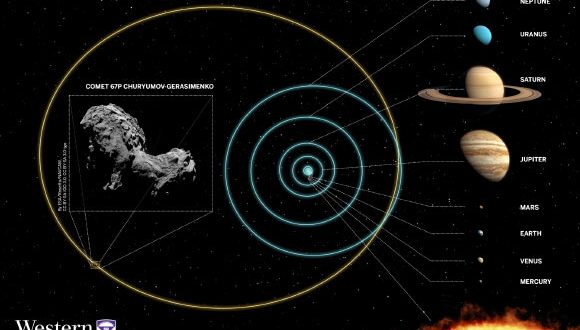67P/Churyumov-Gerasimenko is dynamically a Jupiter-family comet. Its current orbit is very chaotic and it had recently a close encounter with Jupiter.
Mattia Galiazzo and Paul Wiegert from Western University in Canada charted a path that most likely pinpoints the very origins of Comet 67P in the Kuiper belt, a ring of frozen material beyond Neptune’s orbit.
This information is vital for discovering what material the comet is made from and just how long it has been whizzing around our solar system.
But it wasn’t an easy task. Jupiter’s strong gravitational tug warped the path somewhat.
“The details are obscure but we can establish a dynamical pathway from its current orbit back to the Kuiper belt,” Galiazzo says.
And the US Planetary Science Institute’s Jordan Steckloff’s simulations showed the bright plumes of material that flared from Comet 67P were not driven by internal pressure, as is seen for geysers on Earth, but from avalanches.
Comets have regions at the base of slopes and cliffs that are rich in icy materials.
These patches sublimate, or transition from ice directly into gas.
As this gas leaves the surface of the comet, it produces a weak breeze.
And when granular materials slide downslope or over a cliff, they enter this sublimation breeze and are blown into a plume of material that whisks off the comet’s solid surface.
Steckloff’s model is consistent with data collected by the Rosetta spacecraft.
“Ultimately, understanding this novel mechanism of outbursting may allow the surface processes of distant comets to be studied from Earth through ground-based observations of their outbursts,” he said.
Agencies/Canadajournal
 Canada Journal – News of the World Articles and videos to bring you the biggest Canadian news stories from across the country every day
Canada Journal – News of the World Articles and videos to bring you the biggest Canadian news stories from across the country every day



